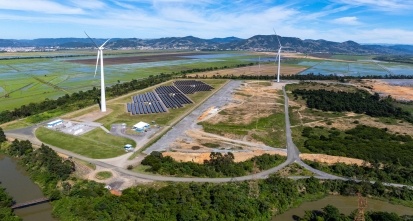Gain new perspectives for faster progress directly to your inbox.
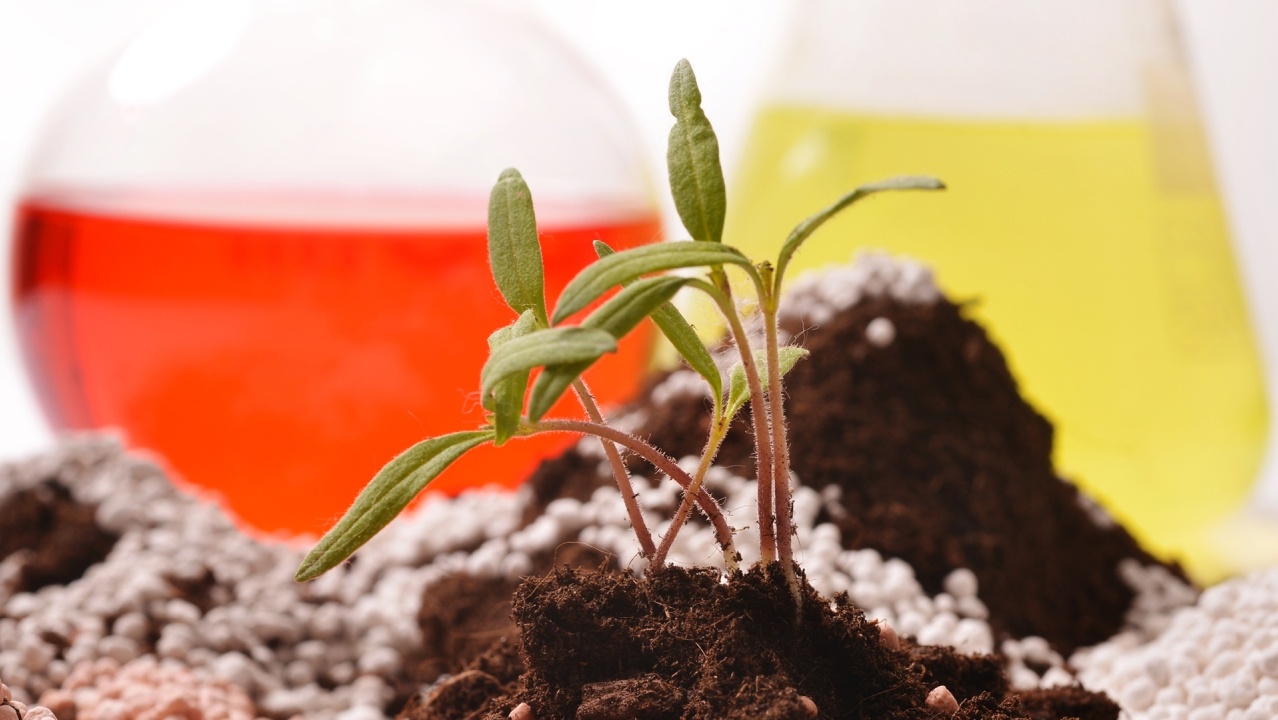
The key role of sustainable agriculture in global food production
It is predicted that the total global food demand is set to rise by 35–56% between the years 2010 and 2050, compounded by a steady increase in the global population. In recent years, the rising costs of food production and distribution has been affected by the COVID-19 pandemic, the Russia–Ukraine war, climate change, and regional conflicts. The International Monetary Fund has emphasized that policy changes are vital to reduce food insecurity and improve fertilizer access, especially in poorer countries.
Synthetic and organic fertilizers continue to be crucial for sustaining farming practices. Synthetic fertilizers use phosphorus mined from phosphate rocks, potassium mined from potash ores, and nitrogen fixed from atmosphere, yet the processes for the extraction of these resources are energy intensive and thus exert a long-term detrimental impact on the environment through mining activities and use of fossil fuel energy sources in their production. Organic fertilizers include manure from various animals, alfalfa meal, blood meal, fish meal, and wood ash, as well as waste from water or sewage. Manure and other wastes that form organic fertilizers are bulky and expensive to transport for field application or disposal, but nutrients being derived from these types of waste can remove the need for costly transport if they can be processed on-site or near where they are produced.
A sustainable agriculture system involves efficient use of water, energy, and nutrient resources; reducing environmental impact, maintaining economic strength, and minimizing dependence on finite depleting resources, allowing both current and future generations to thrive. An example of how nutrients are recovered, reused, and recycled from wastewater for use in fertilizers is shown in Figure 1.
Fertilizer macronutrients are one such finite depleting resource. For example, phosphate reserves may be depleted within the next 50–100 years . In addition, waste agricultural products may also be harmful to the environment, leading to issues such as contamination of crops with pharmaceutical, pathogen, or metal waste, and eutrophication of surface waters. However, these wastes present significant potential, owing to their high nutrient volume.
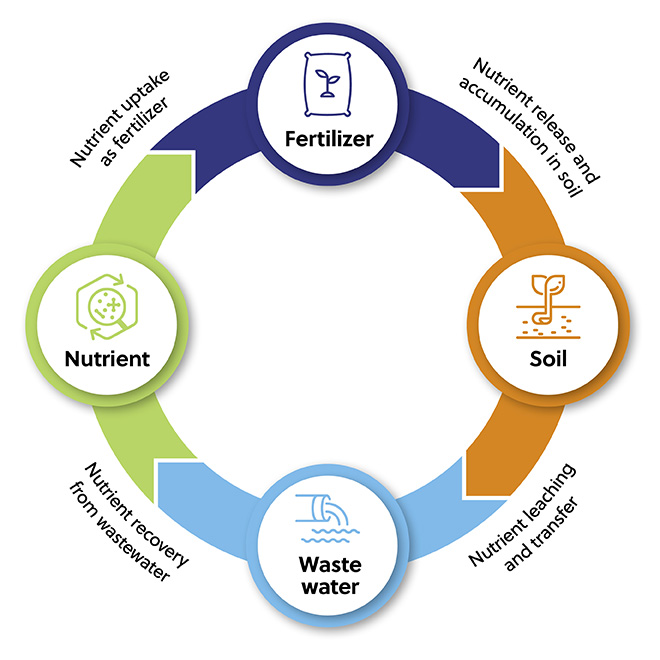
On the path to sustainable agriculture: opportunities to harness innovation
The term circular bioeconomy refers to ways of transforming and managing our land, food, health and industrial systems via the management of biological resources to achieve a sustainable wellbeing in harmony with nature. By harnessing innovation in sustainable agriculture, there is significant potential in exploiting the nutrient content in waste products to bolster food production and minimize environmental impact. Commonly used biological, chemical, and physical methods of nutrient recovery are summarized in Table 1. Potentially sustainable methods that have garnered interest in recent years include:
- Smart nano-fertilizers: Nitrogen nanofertilizers are expected to increase Nitrogen Use Efficiency by improving the effectiveness of nitrogen delivery to plants and reducing nitrogen losses to the environment. This can be performed in a number of ways, via reducing fertilizer volume to nanoparticles, supplementing fertilizer with nanomaterials, or forming nanocomposite structures via encapsulation or storage in nanopores to control nutrient release.
- Biorefineries: In comparison to first-generation biorefineries that utilized crops as feedstock, second-generation biorefineries use residual and waste streams. Biomass is converted into liquid fuels and chemical compounds by enzymes and microorganisms using various conversion platforms.
- Biochar (charcoal): While the use of biochar is a relatively novel concept in carbon sequestration, the history of this charcoal-like substance dates back 2000 years to the Amazonian basin, where adding charred biomass to soil was thought to improve soil quality and fertility. Anaerobic pyrolysis of organic matter such as dead plants or leaf litter is a clean and energy-efficient approach to producing a stable form of carbon.
- Green ammonia: This is the process of making ammonia 100% renewable and carbon-free, using renewable energy, nitrogen, and water. Green ammonia synthesis projects that use water electrolysis to supply H2 have been commercialized in recent years by major companies, including Air Products, Siemens, OCP, thyssenkrupp, and Grupo Fertiberia.
- Struvite: Struvite, also known as guanite or magnesium ammonium phosphate (MAP), is a crystal in which Mg2+, (NH4)+, and PO43- are combined in the molar ratio or stoichiometric proportions of 1:1:1. It can be used either alone or in complex fertilizer formulations with other waste-derived products, microbial inoculants, or conventional inorganic fertilizers. Its high-nutrient composition and slow-release properties make it an attractive candidate for commercial fertilizer production
Table 1. Overview of commonly used nutrient recovery processes from waste
| Method | Description |
| Biological | |
|
Anaerobic digestion
|
|
| Composting |
|
|
Vermicomposting
|
|
|
Chemical
|
|
|
Chemical precipitation and crystallization
|
|
|
Ion-exchange membrane electrolysis (ED)
|
|
|
Physical
|
|
|
Incineration, gasification, and pyrolysis ash nutrient recovery
|
|
|
Forward osmosis (FO)
|
|
|
Adsorption, absorption, and sorbents
|
|
|
Membrane filtration
|
|
Sustainable agriculture trends in fertilizer research and nutrient recovery
The CAS Content Collection™ is an expert-curated resource that was used to evaluate methods of nutrient recovery and the concepts driving innovation and therefore maintaining our circular bioeconomy. A broad fertilizer search retrieved 121,213 patents and 125,228 journal publications over the 2001–2021 period (Figure 2). Journal-related topics focused on the effects of fertilizers on crop plant growth, biological responses, and soil fertility were studied, with some focusing on processes of recovery of nutrients for fertilizers and nutrients as pollutants that cause the eutrophication of receiving waters, or agricultural wastes and soils containing pollutants. Patent-related topics focused on organic substances and processes associated with fertilizer nutrient recovery, fertilizer formulations, and biowaste topics such as manure, ashes, and fermentation.
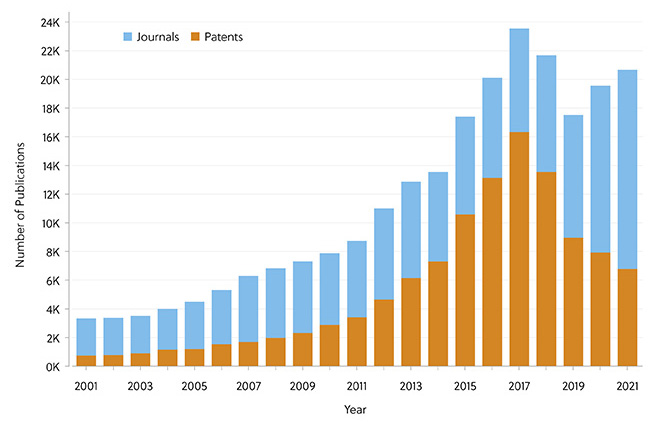
A search was performed to identify sustainable agriculture trends for exploiting nitrogen, phosphorus, and potassium as nutrient sources, as well as the processes for their recovery.
In both journals and patents, substance classes such as "organic/inorganic small molecules", "elements", and "salts/compounds" dominated, with "mixtures" also being prevalent in patents.
Biological processes were the most prominent methods for nutrient recovery, accounting for 66% of journal/patent publications, followed by physical methods (22%) and chemical methods (12%).
Key topics of interest focused on nutrient recovery from wastewater treatment sludge, biochar, and ashes. There were notable trends in biochar production, struvite precipitation, and green ammonia synthesis.
A clear increasing trend in charcoal/biochar topics was noted in patents and journals, with journal publications demonstrating continued growth despite a slight drop in 2019. Patent publications around sustainable agriculture have grown, especially since 2013, although the numbers year-over-year have been somewhat variable (Figure 3). A conceptual analysis revealed relationships between “wastewater treatment sludge” and “manure” with “anaerobic biological digestion”.
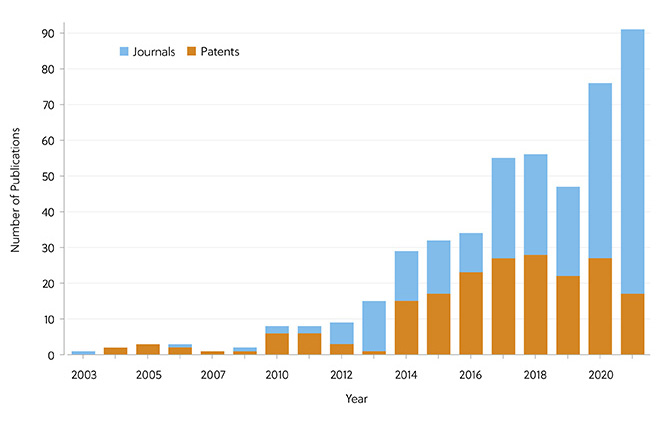
Struvite publications increased substantially during the period studied. Struvite in the form of [(NH4)Mg(PO4).6H2O] was dominant; very little has been published on potassium struvite [MgK(PO4).6H2O] (Figure 4), although some research indicates that it can be recovered with the potential to serve as a magnesium phosphate fertilizer. Key concepts relating to struvite production included "chemical precipitation", "crystallization", "wastewater treatment settling", and "adsorptive wastewater treatment".
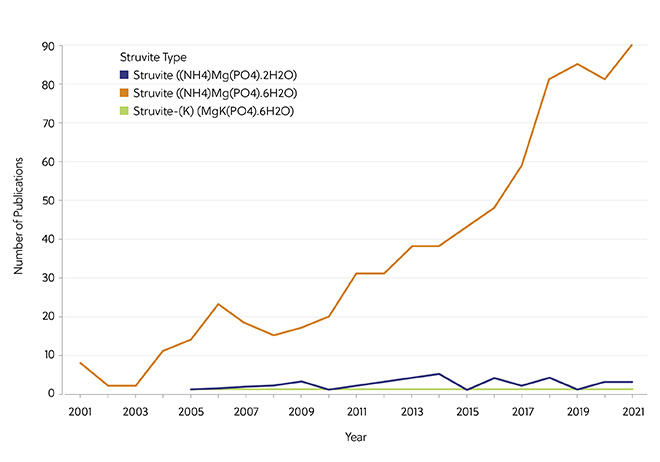
(2001–2021) from a search on sustainable fertilizers.
Green ammonia was discussed primarily in journal publications, with patent documents reaching 20% of the total publication volume in 2020. There was dramatic growth in substances with a role in catalytic green ammonia synthesis from 2017 to 2021; numbers increased from less than 100 distinct substances in 2017 to nearly 500 distinct substances in 2021. Substances of interest were those that comprise new catalysts used in green ammonia synthesis, e.g., inorganic materials, organic/inorganic small molecules, elements, and co-ordination compounds (Figure 5). Moreover, the proportion of journal publications featuring photocatalytic or electrocatalytic nitrogen reduction grew from 1% in 2001 to 25% in 2021, highlighting the rapid advancement of this method.
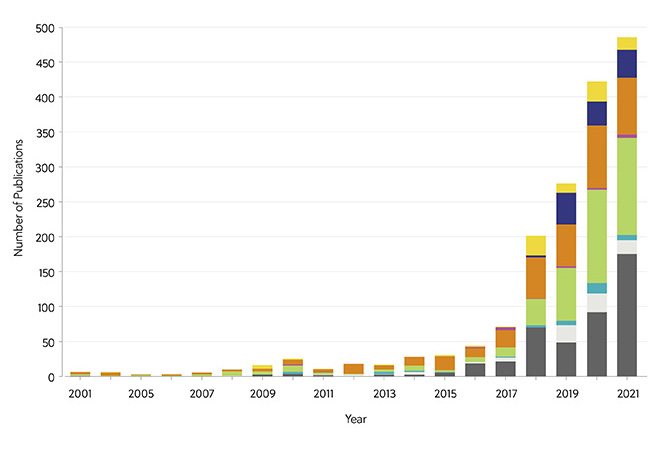
Is climate-resilient agriculture on the horizon?
With a burgeoning global population comes mounting pressures on the agrifood industry. Both fertilizer production and the accumulation of agricultural wastes are contributing to irreversible environmental damage. Sustainability and the concept of a circular bioeconomy have become a core principle of responsible farming practice. Principles of sustainable agriculture have inspired research into the development of integrated systems for waste treatment, nutrient recovery, and energy efficiency.
Alternative “greener” processes for fertilizer production, such as green ammonia synthesis and the recovery of fertilizer nutrients from waste and microbial formulations, have the potential to change the way our food is produced and can convert waste into valuable by-products.
Nutrient recovery processes are being commercialized to help streamline efficiencies, reduce costs, and minimize environmental impact. Some notable sustainable agriculture technologies include:
- Pearl® and WASSTRIP® (Waste Activated Sludge Stripping to Remove Internal Phosphorus) technologies (Ostara Nutrient Recovery Technologies Inc., Canada) are key processes for phosphorus removal used to produce Crystal Green®, a sustainably recovered slow-release fertilizer containing phosphorus, nitrogen, and magnesium. The Root-Activated™ release optimizes uptake and protects local water resources, while increasing yield.
- AirPrex® (CNP CYCLES GmbH, Germany) is a patented sludge optimization process that improves biological phosphate elimination. In the AirPrex® reactor, digested sludge is treated to ultimately lead to precipitation of MAP, or struvite, which can be used as fertilizer.
- AshDec® Thermochemical P-Recovery system (Metso Outotec, Finland) improves plant availability and reduces heavy metal content through recovery of phosphorus from sewage sludge ash. The phosphorus product is citrate soluble, and hence environmentally friendly. Furthermore, phosphorus release is controlled — it only takes place in the presence of crop root exudates.
- The RecoPhos Project (The RecoPhos Consortium) is a multidisciplinary project undertaken by academia, industry, and enterprise. The objective is to recover phosphorus (as white phosphorus or phosphoric acid) from sewage, sludge, and ashes using an innovative reactor. This work will provide the basis for implementing a fully operational bench scale reactor and the design of a pilot scale plant. The economic, environmental, and social impact of the RecoPhos process will also be evaluated.
- The Aqua2™N Process (Easymining Services, Sweden) recovers nitrogen from sludge liquor. Nitrogen is adsorbed and harvested as crystals, which is then recovered as in a form that is readily applicable for fertilizer production. The absorption agent can simply be used again.
Initiatives such as these are proof that cross-sector collaboration amongst science, technology, and industry is the way forward to not only overcome challenges with food production, but also streamline waste recovery. Sustainable agriculture presents a sure way to future-proof our society.
Learn more about sustainable agriculture trends in nutrient recovery processes in our Insight Report.



